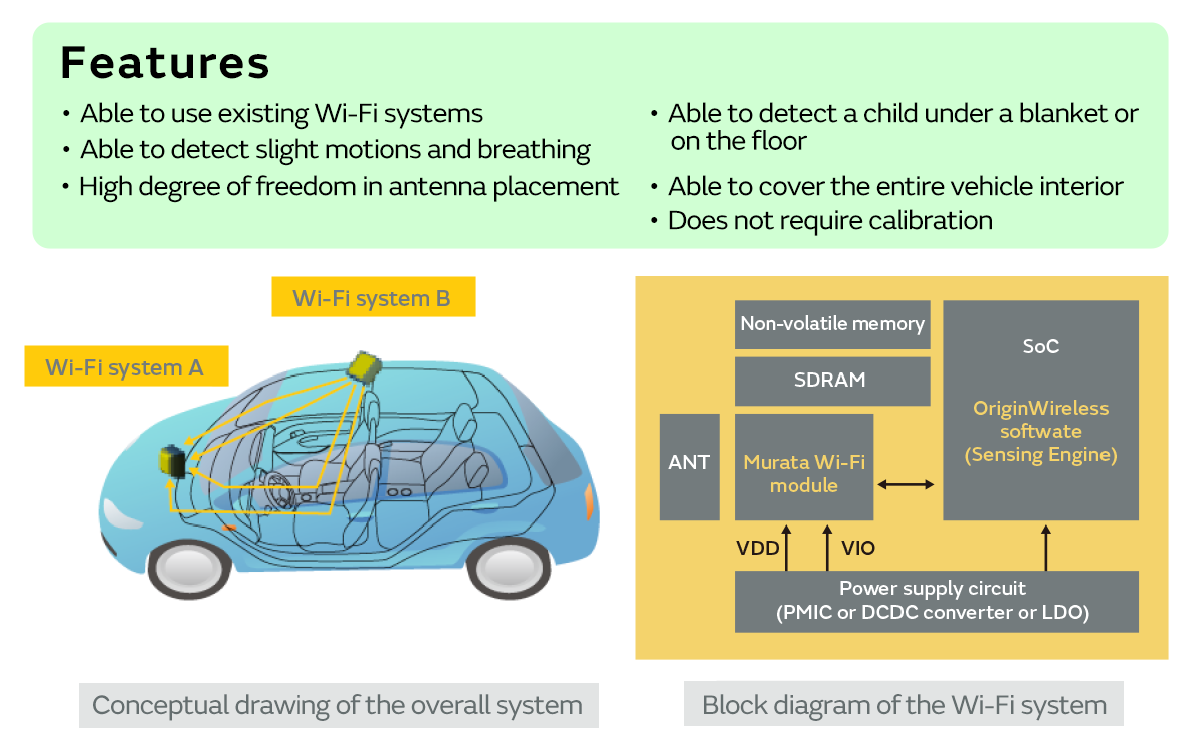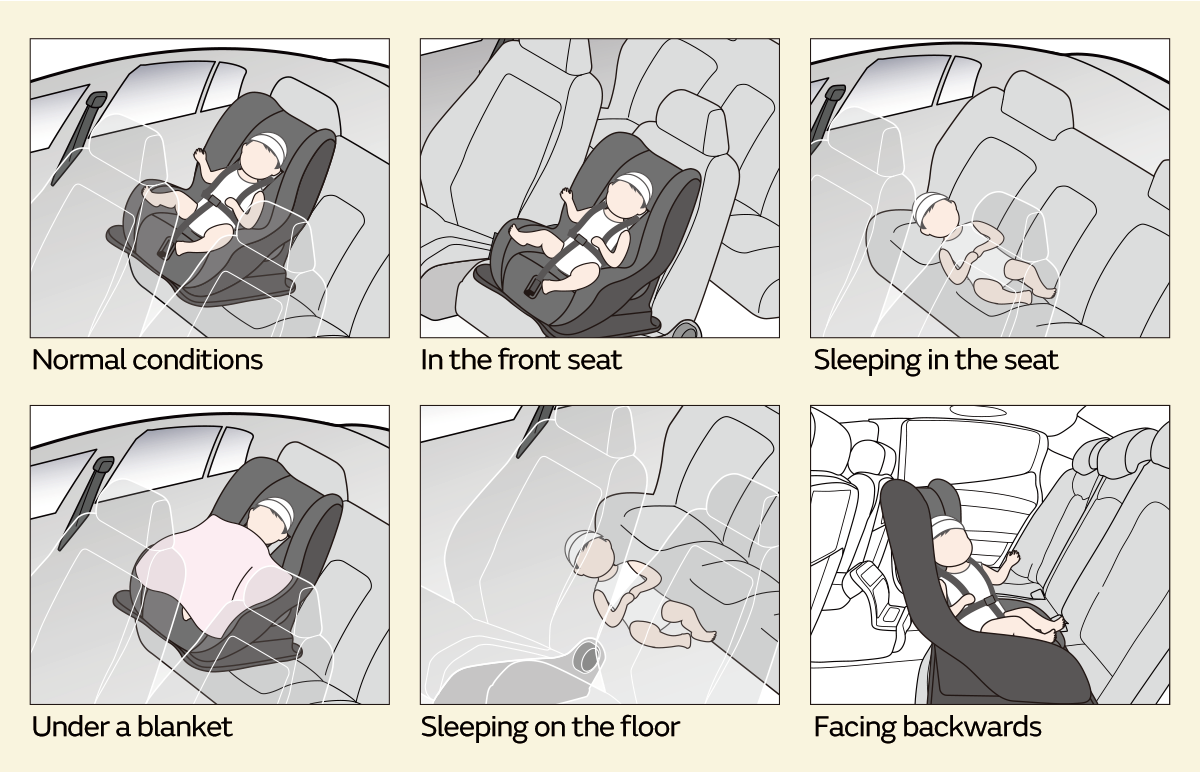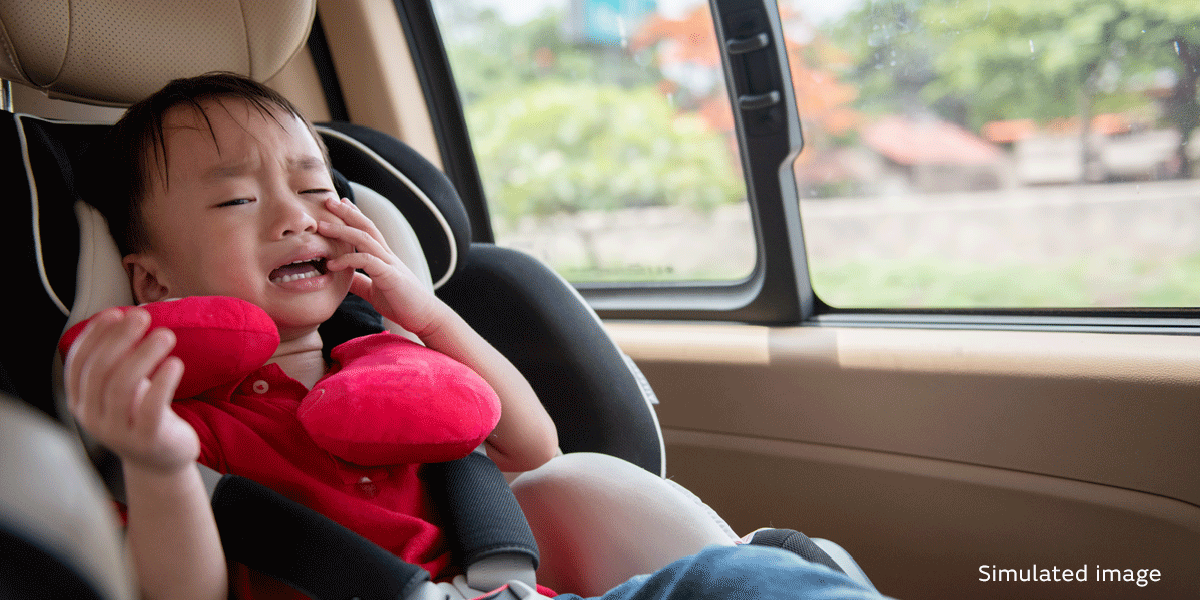Leaving Children Unattended in a Car is Unforgivable Wi-Fi Sensing Technology for the Protection of Children
Preventing the abandonment of children with car features
The movement to improve car safety by fully utilizing electronic technology is gaining momentum. "Advanced Emergency Braking Systems (AEBS)" that automatically apply the brakes in situations where a traffic accident appears imminent are now routinely equipped on new vehicles. While this safety feature will become mandatory in Japan starting from November 2021, the movement to ensure safety using electronic technologies has expanded to include the inside of the vehicle as well.
"A child was left alone inside a car under the hot sun and died of heat stroke." Such heartbreaking stories seem to make the news every year, and death may occur even if children are left unattended while sleeping. Leaving a child unattended in a vehicle is a crime that corresponds to "Abandonment by a Person Responsible for Protection (Article 218 of the Japanese Penal Code)." However, there continue to be cases in which people selfishly think, "It will be all right for a little while. Waking up a sleeping child is so cruel," which can lead to irreparable harm.
Leaving children unattended inside of vehicles is regarded as a problem not only in Japan but throughout the world. The recognition of this problem is particularly high in Europe and the U.S., such that the police are notified if a parent even parks a car in a convenience store lot and leaves a child unattended while shopping. Moreover, the movement to address this problem has expanded beyond merely holding parents responsible, to requiring that vehicles be equipped with features that prevent children from being left unattended.
Under the "European New Car Assessment Program (Euro NCAP)" safety test program for new vehicles being introduced in the European market, tests of "Child Presence Detection (CPD)"-related features are scheduled to be introduced starting in 2023. The results of these safety tests conducted by consumer organizations will be publicized, and the organizations themselves have an extremely high level of authority and can significantly influence vehicle sales depending on the test ratings. In addition, similar trends are starting to be seen in the U.S., ASEAN, Japan, and the rest of the world.
Child Presence Detection with a sensing technology utilizing Wi-Fi signals
In anticipation of the coming era in which all vehicles will be equipped with CPD features, automobile manufacturers around the world are simultaneously developing these features. Achieving a higher rating requires the implementation of a feature that can accurately detect and appropriately handle an unattended child under any circumstances.
Murata Manufacturing (hereinafter, "Murata") is jointly developing and offering a technology together with Origin Wireless that can accurately detect the presence of a child by utilizing the Wi-Fi (wireless LAN) signals that are used as a way of connecting electronic devices with the car interior. There are several ways to realize CPD such as recognizing images obtained from cameras and using millimeter wave radar, etc. Among these methods, Wi-Fi-based sensing provides many unique features not found in other methods, and expectations are growing that it will become an essential technology for the broad adoption of safer vehicles (Fig. 1).

Equipping CPD features using existing on-board Wi-Fi system with minimum cost and work needed
Wi-Fi is an essential technology for wirelessly connecting PCs and printers, etc. in the office and home. Murata's CPD implementation technology utilizes Wi-Fi communication technology to protect children. In contrast to technologies that use cameras, millimeter wave radar, and other sensors to detect the presence of people and objects, this technology offers many useful features. To learn more about the features of this technology offered by the company, we spoke with Mr. Kadota, the manager of product engineering for the Wi-Fi-based sensing technology for CPD at Murata.
CPD to become a safety evaluation item for vehicles in Europe starting in 2023
--Under the Euro NCAP program, what types of CPD-related tests will be implemented and when will they come into effect?
CPD will be subject to Euro NCAP scoring starting from 2023. The working group is currently discussing what types of tests will be implemented, what features will be scored, the test specifications, and scoring standards. It is believed that such information will be released during 2021*. Similar trends are being promoted under the ASEAN NCAP program, and there is a strong possibility that North America and Japan will also follow suit. In some cases, manufacturers may be legally required to equip CPD features.
It is not always the case that children are sitting quietly in a childseat in the back. We need sensing technologies that can accurately detect the presence of a child no matter where they are inside the vehicle and under any conditions.
* This protocol was released as "Child Presence Detection Test and Assessment Protocol" in July 2021.
--Is it technically difficult to accurately detect the presence of a child?
Considerably advanced technology is required to ensure the detection does not miss anything. For example, if a child is sleeping under a blanket, you would not know it is there from a quick glance. Moreover, if a child is moving around inside the vehicle, it is difficult to predict where they are, and they may in some cases even be lying on the floor (Fig. 2). In addition, you also have to anticipate pitch-dark conditions inside the vehicle at night.

--What are the important points for automobile manufacturers when selecting a CPD implementation technology?
The test specifications are yet to be decided, but many automobile manufacturers are already evaluating technologies for adoption. In particular, the European automobile manufacturers are leading in the evaluation process.
First, cost is a very important element. Various assessments are performed under NCAP, and the scores for each item are finally added up to determine the grade. While luxury vehicles may be able to pack in every type of safety feature, that only applies to some car models. The strategies of each automobile manufacturer will become apparent in the types of safety features they decide to invest in to obtain a high-grade assessment. Therefore, technologies that can minimize cost as much as possible while satisfying the required specifications are also required for CPD. However, as discussed a moment ago, the major premise of such technologies is that it is essential that they have the ability to accurately detect the presence of a child under any circumstances.
Utilizing Wi-Fi signals that reach every corner of the vehicle interior
--Murata offers a technology that utilizes Wi-Fi signals to accurately detect the presence of a child. Please tell us about the principle of detection.
The system detects fluctuations in the multipath waves of the Wi-Fi signals bouncing around inside the vehicle to detect the movement of a child (Fig. 3). Devices that transmit and receive the signals are placed in separate locations within the vehicle interior. When the signals are propagating from the transmitting side to the receiving side, they are reflected by the body surrounding the interior as well as the seats and various other objects inside the vehicle, creating many signal propagation paths (routes). If there are no moving objects within the interior, the combined wave of such multipaths will be continuously stable. However, if a person moves in the vehicle interior, the amplitude of the combined wave will fluctuate. The system analyzes the amount of variation to detect the presence of a person.

--How accurately can it detect movement?
It is able to detect head movements at the level of even a few centimeters and can tell if someone is breathing. The final test specifications for Euro NCAP will be released going forward, but we believe that the requirements can definitely be satisfied with the Wi-Fi-based method offered by Murata. Moreover, because the signals reach every location inside the vehicle, it is able to detect without any blind spots. In addition, even if a child is covered by a blanket, the signals can penetrate the blanket so as not to miss the child.
--What frequency band does it utilize for detection?
We recommend the use of the 5 GHz band that has a high sensing accuracy. I would like to emphasize that the hardware used for data communication with electronic devices can be used without any alterations of the devices used to send and receive the signals. In other words, you can implement two features for communication and CPD with the same devices and use them at the same time.
The majority of car navigation systems around the world are already equipped with Wi-Fi. In addition, Wi-Fi is also being used in telematic control units for vehicular emergency reporting systems, which are required in Europe and the U.S., and the number of cars equipped with two devices for sending and receiving Wi-Fi signals is increasing every year. With such cars, you can add CPD features just by introducing compatible software. In order to achieve sensing with high precision, the antenna position and orientation, etc. must be slightly adjusted according to the size and shape, etc. of the car, but that is about the only area that requires correction. The locations for installing the Wi-Fi transmitters and receivers can be freely selected, and I think that it is a technology that is easy for enterprise users to implement.
Applicable to modules that support Wi-Fi 5 and above
--How is Murata providing the Wi-Fi based CPD technology to the automobile industry?
We provide a high-reliability Wi-Fi module for on-board use to which CPD can be applied. However, rather than prepare a special product for CPD, we will directly deploy Wi-Fi modules embedded in car navigation systems, etc. for CPD as well. If you have a product that is compatible with IEEE802.11ac (Wi-Fi 5) and later standards that is already being mass-produced, then it can be used for CPD. Of course, that also applies to IEEE802.11ax (Wi-Fi 6) compatible modules. The software for implementing CPD features is provided by Origin Wireless, the developer of this technology.
--I understand that the technology is already being introduced to automobile manufacturers, but how have they responded?
On the technical side, we have received very high evaluations and feel that it is a positive response for the spread of this technology. Because it appears that Murata is the only company proposing a method that utilizes Wi-Fi signals as a means for implementing CPD, it seems that they are interested in the technology itself. Speaking of Wi-Fi, most people have the impression that it is a means of communication but are surprised to learn that it can be used for sensing.
As we enter the CASE era, we believe that the spread of connectivity will further expand and be utilized for various applications. By adding CPD features through this technology, even more added value can be offered. We will carefully highlight the appeal of this technology including such advantages.
CPD features can also be deployed for next-generation, high value-added mobile services
CPD features are utilized in order to ensure the safety of children riding in cars, but those features can be used in various scenarios and for a variety of purposes.
For example, there are concepts that use fully autonomous vehicles, which are now being developed around the world, as mobile offices, hotels, and restaurants. To provide such next-generation, high value-added mobile services, mechanisms for accurately understanding and managing the status of users within the cabin space are essential for increasing safety and comfort. However, from the perspective of protecting the privacy of users, we cannot install interior cameras and monitor them. At such times, sensing that uses Wi-Fi signals is extremely useful as a means for indirectly assessing the situation.
The Wi-Fi sensing technology proposed by Murata may be broadly utilized as a technology that meets the demands of such an era.

